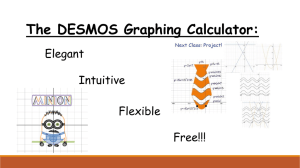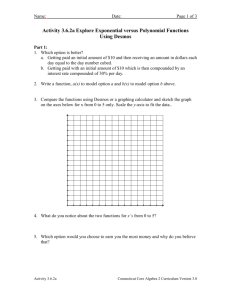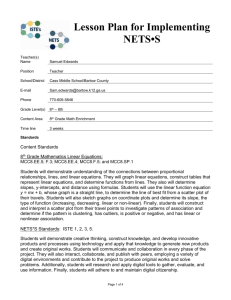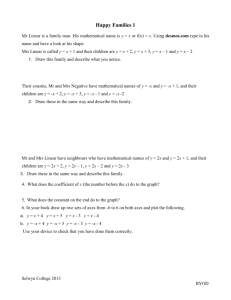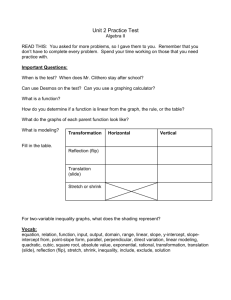Math Lab 3
advertisement
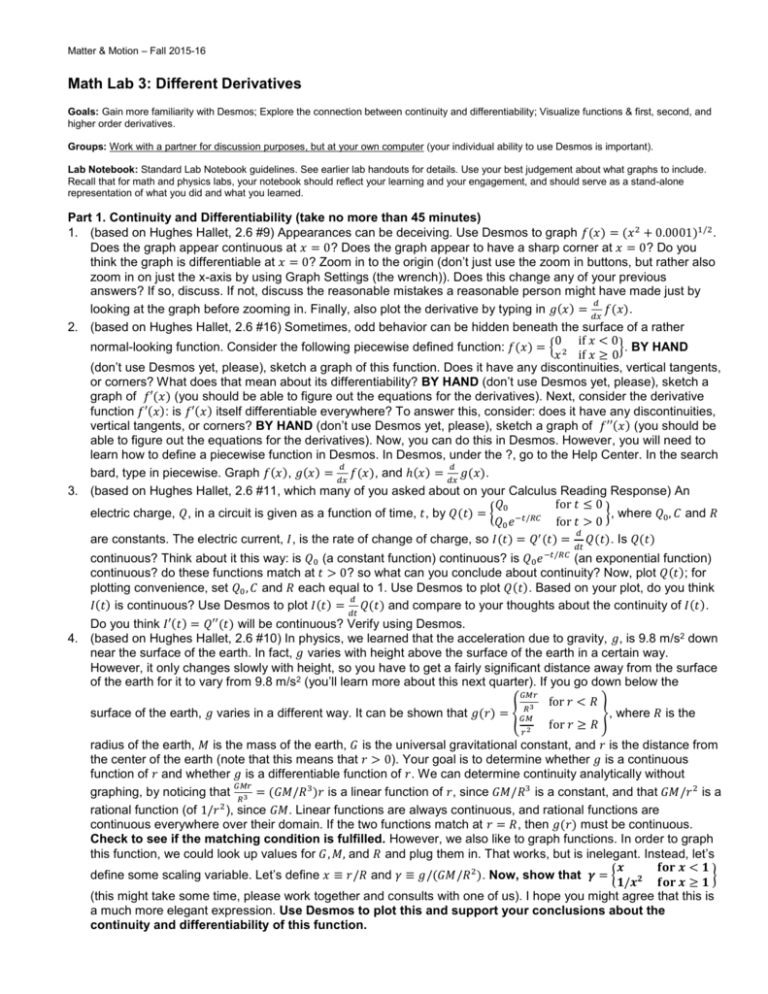
Matter & Motion – Fall 2015-16
Math Lab 3: Different Derivatives
Goals: Gain more familiarity with Desmos; Explore the connection between continuity and differentiability; Visualize functions & first, second, and
higher order derivatives.
Groups: Work with a partner for discussion purposes, but at your own computer (your individual ability to use Desmos is important).
Lab Notebook: Standard Lab Notebook guidelines. See earlier lab handouts for details. Use your best judgement about what graphs to include.
Recall that for math and physics labs, your notebook should reflect your learning and your engagement, and should serve as a stand-alone
representation of what you did and what you learned.
Part 1. Continuity and Differentiability (take no more than 45 minutes)
1. (based on Hughes Hallet, 2.6 #9) Appearances can be deceiving. Use Desmos to graph 𝑓(𝑥) = (𝑥 2 + 0.0001)1/2 .
Does the graph appear continuous at 𝑥 = 0? Does the graph appear to have a sharp corner at 𝑥 = 0? Do you
think the graph is differentiable at 𝑥 = 0? Zoom in to the origin (don’t just use the zoom in buttons, but rather also
zoom in on just the x-axis by using Graph Settings (the wrench)). Does this change any of your previous
answers? If so, discuss. If not, discuss the reasonable mistakes a reasonable person might have made just by
𝑑
looking at the graph before zooming in. Finally, also plot the derivative by typing in 𝑔(𝑥) = 𝑓(𝑥).
𝑑𝑥
2. (based on Hughes Hallet, 2.6 #16) Sometimes, odd behavior can be hidden beneath the surface of a rather
0 if 𝑥 < 0
normal-looking function. Consider the following piecewise defined function: 𝑓(𝑥) = { 2
}. BY HAND
𝑥 if 𝑥 ≥ 0
(don’t use Desmos yet, please), sketch a graph of this function. Does it have any discontinuities, vertical tangents,
or corners? What does that mean about its differentiability? BY HAND (don’t use Desmos yet, please), sketch a
graph of 𝑓′(𝑥) (you should be able to figure out the equations for the derivatives). Next, consider the derivative
function 𝑓′(𝑥): is 𝑓′(𝑥) itself differentiable everywhere? To answer this, consider: does it have any discontinuities,
vertical tangents, or corners? BY HAND (don’t use Desmos yet, please), sketch a graph of 𝑓′′(𝑥) (you should be
able to figure out the equations for the derivatives). Now, you can do this in Desmos. However, you will need to
learn how to define a piecewise function in Desmos. In Desmos, under the ?, go to the Help Center. In the search
𝑑
𝑑
bard, type in piecewise. Graph 𝑓(𝑥), 𝑔(𝑥) = 𝑓(𝑥), and ℎ(𝑥) = 𝑔(𝑥).
𝑑𝑥
𝑑𝑥
3. (based on Hughes Hallet, 2.6 #11, which many of you asked about on your Calculus Reading Response) An
𝑄0
for 𝑡 ≤ 0
electric charge, 𝑄, in a circuit is given as a function of time, 𝑡, by 𝑄(𝑡) = {
}, where 𝑄0 , 𝐶 and 𝑅
𝑄0 𝑒 −𝑡/𝑅𝐶 for 𝑡 > 0
𝑑
are constants. The electric current, 𝐼, is the rate of change of charge, so 𝐼(𝑡) = 𝑄′ (𝑡) = 𝑄(𝑡). Is 𝑄(𝑡)
𝑑𝑡
continuous? Think about it this way: is 𝑄0 (a constant function) continuous? is 𝑄0 𝑒 −𝑡/𝑅𝐶 (an exponential function)
continuous? do these functions match at 𝑡 > 0? so what can you conclude about continuity? Now, plot 𝑄(𝑡); for
plotting convenience, set 𝑄0 , 𝐶 and 𝑅 each equal to 1. Use Desmos to plot 𝑄(𝑡). Based on your plot, do you think
𝑑
𝐼(𝑡) is continuous? Use Desmos to plot 𝐼(𝑡) = 𝑄(𝑡) and compare to your thoughts about the continuity of 𝐼(𝑡).
𝑑𝑡
Do you think 𝐼′(𝑡) = 𝑄′′(𝑡) will be continuous? Verify using Desmos.
4. (based on Hughes Hallet, 2.6 #10) In physics, we learned that the acceleration due to gravity, 𝑔, is 9.8 m/s2 down
near the surface of the earth. In fact, 𝑔 varies with height above the surface of the earth in a certain way.
However, it only changes slowly with height, so you have to get a fairly significant distance away from the surface
of the earth for it to vary from 9.8 m/s2 (you’ll learn more about this next quarter). If you go down below the
𝐺𝑀𝑟
3
𝑅
surface of the earth, 𝑔 varies in a different way. It can be shown that 𝑔(𝑟) = {𝐺𝑀
𝑟2
for 𝑟 < 𝑅
for 𝑟 ≥ 𝑅
}, where 𝑅 is the
radius of the earth, 𝑀 is the mass of the earth, 𝐺 is the universal gravitational constant, and 𝑟 is the distance from
the center of the earth (note that this means that 𝑟 > 0). Your goal is to determine whether 𝑔 is a continuous
function of 𝑟 and whether 𝑔 is a differentiable function of 𝑟. We can determine continuity analytically without
𝐺𝑀𝑟
graphing, by noticing that 3 = (𝐺𝑀/𝑅3 )𝑟 is a linear function of 𝑟, since 𝐺𝑀/𝑅3 is a constant, and that 𝐺𝑀/𝑟 2 is a
𝑅
rational function (of 1/𝑟 2 ), since 𝐺𝑀. Linear functions are always continuous, and rational functions are
continuous everywhere over their domain. If the two functions match at 𝑟 = 𝑅, then 𝑔(𝑟) must be continuous.
Check to see if the matching condition is fulfilled. However, we also like to graph functions. In order to graph
this function, we could look up values for 𝐺, 𝑀, and 𝑅 and plug them in. That works, but is inelegant. Instead, let’s
𝒙
𝐟𝐨𝐫 𝒙 < 𝟏
define some scaling variable. Let’s define 𝑥 ≡ 𝑟/𝑅 and 𝛾 ≡ 𝑔/(𝐺𝑀/𝑅2 ). Now, show that 𝜸 = {
}
𝟏/𝒙𝟐 𝐟𝐨𝐫 𝒙 ≥ 𝟏
(this might take some time, please work together and consults with one of us). I hope you might agree that this is
a much more elegant expression. Use Desmos to plot this and support your conclusions about the
continuity and differentiability of this function.
Part 2. Visualizing Derivatives (take no more than 45 minutes)
Here, you will use visualization tools to get more experience with graphs of functions and their derivatives. This looks
short but it is potentially rich with exploration.
1. Go to phet.colorado.edu and click on Play with Simulations.
2. Click on Math.
3. Click on Calculus Grapher, and follow any prompts to run it, but don’t install any updates now. Under View, turn
on Integral, Derivative, Cursor, and Grid. Play around with this, making interesting functions. Pay particular
attention to the relationship between the graph of a function and the graph of its derivative. To save any graphs
you are particularly proud of, I think you will need to take screen shots (ask if you are not sure how to do this – it’s
a useful skill).
4. Go back to the Math page, and scroll down a bit to find The Moving Man (why not The Wandering Woman, I
wonder?). This one will probably prompt you several times in order to run; accept the prompts but again don’t
install any updates now. Go to Charts. Play around with this as well. Note that you can either move the figure
around and see the graphs of position vs. time, velocity vs. time, and acceleration vs. time. Or you can move any
of the graphs around (use the arrows, you’ll need to hit the play button as well) and see how the figure moves.
There’s a record and playback feature, and in the Special Features tab at the top, you can enter simple
expressions in the Expression Evaluator. Again, play around with this, with particular attention to the relationship
between functions, their first derivatives, and their second derivatives.
5. Make some functions and their derivatives in Desmos. The first question on the calculus quiz today was a graph
2
of 𝑓(𝑥) = 𝑒 −(10𝑥) − 𝑥/2 (or close to it – I don’t actually remember it exactly). Plot this and its derivative. The
second question was 𝑓(𝑥) = 𝑒 𝑥 − 1. Plot this and its derivative. Try with all of your toolkit functions and fun
variations.
Part 3. Challenge Problem
Go to https://www.desmos.com/calculator/gmrlcathkx Move the slider around and consider the triangles formed by the
x-axis, the y-axis, and the tangent line. Can you make a conjecture about the area of the triangles formed by the
tangent lines at any point and the x-axis and the y-axis? Can you prove your conjecture?

